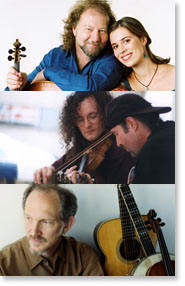|
Given the common complaint that fiddle tunes often sound
too much alike, I wondered how the performers would tackle the challenge
of playing an entire evening of them without including several songs for
variety as Celtic bands usually do. As it turned out, they kept the show
fresh through frequent changes in lineup—each fiddler would solo, play
with either or both accompanists, or huddle in pairs or a trio bowing
madly away with both backup players accompanying.
Opening was Martin Hayes, 45, of County Clare, whose
trademark is slowing down the normally quick Irish dance tunes, with
Chicago-born Dennis Cahill skillfully backing on guitar. As the
deadpan-faced Cahill looked on, Hayes bantered with the audience and
then sat down and played a slow, modal air, “The Wind-Swept Hills of
Tullah.” He followed it with a pair of jigs, “The Cliffs of Mohr,” and
the first of several unidentified fiddle tunes played that night. Hayes’
tone was sweet, his intonation accurate, and like many Irish fiddlers,
he used the upper half of the bow the most.
Cahill was then joined by Bruce Molsky, 52, for a pair of tunes spanning
the Atlantic: the Irish reel “Joe Bann’s” and the Appalachian breakdown
“Billy in the Lowground.” As Hayes took the lead, Molsky demonstrated
second fiddle playing by providing droning harmonies on the bass
strings. In the second tune, Molsky alternated between unison and
harmony playing.
Last in the first set was Alasdair Fraser, 52, from
Clackmannan, Scotland. Fiddle-cello duets, Fraser explained afterwards,
were popular in 18th-century Scotland, played some hornpipes with Hass.
Scottish fiddling is closer in sound to classical violin than its Irish
or Appalachian cousins—Fraser was the only fiddler to use vibrato, for
example—and his style was well matched to Hass’s flawless cello.
The second set saw the only low point of the night, an
original by Fraser called “Valley of the Moon,” which had a vacuous
jam-band-type interlude between two more traditional-sounding tunes. The
music went back uphill from there, though, when Fraser resumed his usual
fare. He offered a set of reels that included “Jenny Dang the Weaver.”
Molsky shined on the old-timey standard “Cotton-Eyed Joe,” and Hayes and
Molsky played Irish and Appalachian versions of the same tune,
“Coleman’s March.”
On they went with the venerable old tunes, and the
moments rolled away until the last chord of the full group’s encore,
“Blackberry Blossom,” handed the audience back over to modern times.
—Glenn Weiser
See the article on
the Metroland website
Index of Metroland
Articles by Glenn Weiser ©2007 by Glenn
Weiser. All rights reserved.
|
